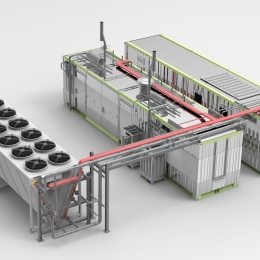Browse components, systems and services for hydrogen industry from leading suppliers on our marketplace!
The hydrogen fuel
Hydrogen fuel has the potential to be a clean, efficient, and flexible energy source with a wide range of applications. Hydrogen can be used as a fuel in fuel cell vehicles, portable power generators, and stationary power systems, and it can also be used as a feed stock for the production of chemicals and materials.
One of the main advantages of hydrogen fuel is that it produces only water when it is burned, making it a clean and environmentally friendly energy source. In addition, hydrogen fuel has a high energy density, meaning that it can store a large amount of energy in a small volume. This makes it well-suited for use in portable and mobile applications, such as fuel cell vehicles.
Energy density and liquefaction of hydrogen
The energy density of a fuel refers to the amount of energy that can be stored in a given volume. Hydrogen as a fuel has a relatively low energy density compared to other fossil fuels, such as oil and natural gas.
However, hydrogen fuel has a high specific energy, which is the amount of energy per unit of weight. This means that it can store a lot of energy in a small weight, making hydrogen as fuel well-suited for use in portable and mobile applications.
Hydrogen gas can be liquefied at low temperatures, around -253°C (-423°F). This process, called cryogenic liquefaction, allows hydrogen to be stored and transported in a liquid form, which can be more convenient and efficient than storing and transporting it as a gas.
Storage of hydrogen fuel
There are several ways to store hydrogen as a fuel for both mobility and stationary applications. Some of the main methods include:
- Compressed hydrogen gas: Hydrogen gas can be stored in high-pressure tanks or cylinders, similar to propane tanks. This is a common method of storing hydrogen in fuel cell vehicles.
- Liquid hydrogen: As mentioned earlier, hydrogen can be liquefied at low temperatures and stored in cryogenic tanks. This is a more efficient method of storing hydrogen, as it takes up less volume than gas. However, it requires specialized equipment and insulation to maintain the low temperature.
- Hydrogen in solids: Hydrogen can be stored in solids, such as metal hydrides or carbon nanotubes, at room temperature. This method has the potential to be very efficient, but it is still in the early stages of development.

Example – Cryogenic tank for hydrogen fuel
How is hydrogen fuel made?
How hydrogen fuel is made has bearings on the cost of production as well as overall environmental impact, or benefit. The main established methods to produce hydrogen fuel are listed below.
Production of hydrogen fuel
- Steam methane reforming: This is the most common method of producing hydrogen, and it involves reacting methane (natural gas) with steam to produce hydrogen and carbon dioxide.
- Coal gasification: This method involves reacting coal with steam and oxygen to produce hydrogen and other byproducts.
- Electrolysis: Electrolysis is a process that uses electricity to split water into hydrogen and oxygen. This process can be powered by renewable energy sources, such as solar or wind power, to produce green hydrogen.
- Biomass gasification: This method involves reacting biomass, such as wood or agricultural waste, with steam and oxygen to produce hydrogen and other byproducts.
Green hydrogen fuel
Green hydrogen is hydrogen fuel that is produced using renewable energy sources, such as solar or wind power. This process, called electrolysis, uses electricity to split water into hydrogen and oxygen.
Green hydrogen has the same chemical properties as hydrogen produced from fossil fuels, but it is considered to be a cleaner and more sustainable option because it does not produce greenhouse gases during production.
Green hydrogen taxonomy
There is currently no official, widely accepted taxonomy for green hydrogen. However, there are several organizations and initiatives that are working to establish standards and definitions for green hydrogen.
For example, the International Renewable Energy Agency (IRENA) has developed a set of guidelines for the classification of renewable hydrogen, which defines green hydrogen fuel as hydrogen fuel produced from renewable electricity through the electrolysis of water.
Hydrogen globally
There are several countries around the world that are actively developing hydrogen technologies and infrastructure. Some of the countries that are currently leading the way in hydrogen development include:
- Japan has been a pioneer in hydrogen energy, with a strong focus on hydrogen in fuel cell vehicles and stationary power systems. The country has established a comprehensive hydrogen infrastructure, including hydrogen production, transportation, and distribution networks.
- Germany has also been a leader in hydrogen energy, with a focus on hydrogen production from renewable energy sources and the development of fuel cell vehicles.
- South Korea has a strong focus on hydrogen energy, particularly in the areas of fuel cell vehicles and stationary power systems. The country has established a comprehensive hydrogen roadmap and is investing heavily in research and development.
- China is also actively developing hydrogen technologies and infrastructure. In recent years, China has made significant investments in hydrogen research and development, with a focus on fuel cell vehicles, stationary power systems, and hydrogen production. China has established a number of initiatives and programs to support the development of hydrogen technologies, including the “National Hydrogen and Fuel Cell Strategic Plan”, which outlines the country’s goals and strategies for the development of a hydrogen economy. China has a number of companies and research institutions that are actively involved in hydrogen research and development, and the country is home to some of the world’s largest hydrogen production facilities. In addition, China has a growing network of hydrogen refueling stations and is working to expand its hydrogen infrastructure.
- The United States has a growing hydrogen industry, with a focus on fuel cell vehicles and stationary power systems. The country has a number of initiatives and programs in place to support the development of hydrogen technologies.
These are just a few examples, and many other countries around the world are also actively developing hydrogen technologies and infrastructure.
How much does hydrogen fuel cost?
The net cost for hydrogen fuel is impacted by the production method and availability of primary sources of energy. The actual price for hydrogen fuel “at the pump” will not only be impacted by production cost, but also by market demand and the competitive environment. The supply and demand for hydrogen fuel must of course be put into perspective to other fuels available on the market. During a transition period of introduction into the mobility market, the cost of hydrogen fuel per gallon or liter will likely also be impacted by government subsidies and tax incentives.
Last update: 20.01.2023











